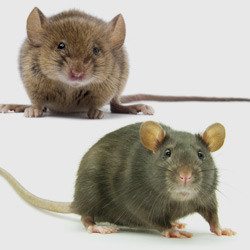
This is the time of year when commercial establishments are most likely to become invaded with rodents. However, it is not enough to just realize you have rodents. Proper identification will greatly enhance your ability to eradicate and control the particular rodent in which you are dealing. Deer mice, house mice, Norway rats and roof rats are among the more common rodents you may experience.
Common Rodents
The deer mouse is found in rural areas and is of medical concern due to being a common carrier of Hantavirus. The adult body of the deer mouse is usually 3-4 inches in length with an additional 2-5 inch long tail. The color varies from pale gray to deep reddish brown with a white belly. The deer mouse feeds on a variety of nuts, berries, seeds and other small animals such as insects, snails, slugs, other dead mice and young birds. They are nocturnal and usually feed at early dawn and again at dusk. Total elimination of the deer mouse indoors is very difficult due to the abundant population outdoors.
The house mouse is a rapid breeding rodent and can be found in almost every corner of the world. A female can produce up to 35 babies each year, setting off population explosions. The adult house mouse is slightly smaller than the deer mouse, measuring 2½-3¾ inches plus a 2¾-4 inch tail. The top of the body is dusty gray with a light gray or cream belly. While the house mouse eats a variety of foods, seeds, grains and insects are the preferred diet. The house mouse does not hibernate and seek shelter as temperatures begin dropping. They are predominantly nocturnal and prefer dark, secluded places in which to build nests. The house mouse gnaws on everything including electrical wiring, causing them to be very destructive to physical properties. They also pose a medical concern with food contamination, especially Salmonella.
Norway rats are of Asian origin but are now found throughout the world. The Norway rat can cause major physical damage through their constant gnawing. They are among the largest of rodents, measuring 7-9 ½ inches with an additional 6-8 inch tail. The Norway rat will eat just about anything but is partial to meat, fish and cereals. They are nocturnal and very shy, showing caution around any new objects or changes. They will nest in basements and lower portions of the building but can occasionally be found in attics, roofs and even sewers. Norway rats are attracted to garbage and can easily contaminate food and eating surfaces.
Roof rats, also referred to as black rats or ship rats, are smaller than Norway rats but have bigger ears and longer tails. Their body measures 6-8 inches with a 7-10 inch tail. The roof rat is found throughout the world and feeds on all kinds of food but prefer seeds, nuts, fruits and berries. They will also feed on insects. The roof rat can damage property and destroy products by constant gnawing, eating and defecating. They have been known to bite humans and transmit diseases. However, the greatest concern is contaminating food and causing Salmonella.
Contact your local Copesan Specialists for proper identification and exceptional pest management services to your commercial business.
